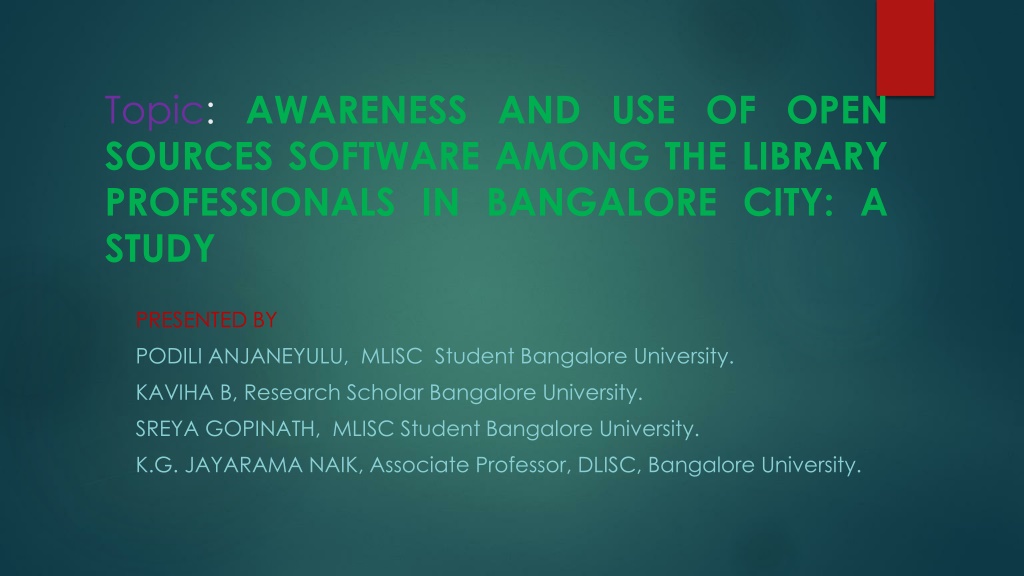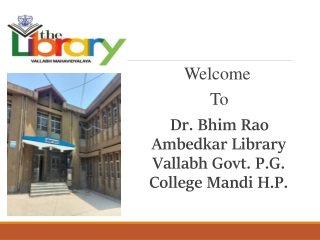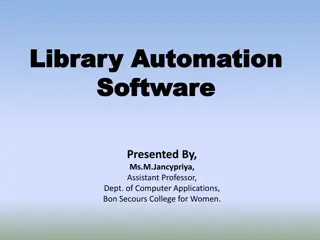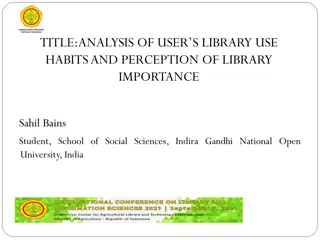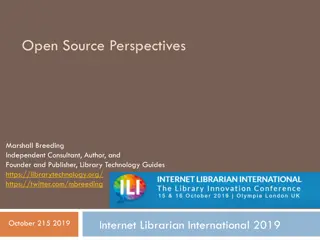Awareness and Use of Open Source Software Among Library Professionals in Bangalore City
This study presented by Podili Anjaneyulu, Kaviha B, Sreya Gopinath, and K.G. Jayarama Naik from Bangalore University focuses on identifying the awareness and usage of open source software among library professionals in Bangalore. The study explores different open source software available for library automation and management, lists various open source software categories, outlines the features of open source software, and describes the methodology used in data collection.
Download Presentation

Please find below an Image/Link to download the presentation.
The content on the website is provided AS IS for your information and personal use only. It may not be sold, licensed, or shared on other websites without obtaining consent from the author. Download presentation by click this link. If you encounter any issues during the download, it is possible that the publisher has removed the file from their server.
E N D
Presentation Transcript
Topic: AWARENESS AND USE OF OPEN SOURCES SOFTWARE AMONG THE LIBRARY PROFESSIONALS IN BANGALORE CITY: A STUDY PRESENTED BY PODILI ANJANEYULU, MLISC Student Bangalore University. KAVIHA B, Research Scholar Bangalore University. SREYA GOPINATH, MLISC Student Bangalore University. K.G. JAYARAMA NAIK, Associate Professor, DLISC, Bangalore University.
INTRODUCTION Open Sources software is computer software whose sources code is available under a licenses. The first OSS began with the establishment of the free software foundation in 1985 founded by Richard Stallman. To Support the free software movement, which promotes the universal freedom to study, distribute, create, and modify computer software through its own general public licence.
Objectives of the Study To identify the awareness of open source software among library professionals. To identify different open source software available for library automation and management. To identify the use of open source software To identify the barriers in the use of open source software
List of Open sources Softwares Open source operating systems Ubuntu OpenSUSE CentOs Debian Linux BOSS Fedora Linux Mint
Open sources Library Management Softwares Koha Newgenlib Openbiblio Evergreen Phpmylibrry
Open sources Digital Library Softwares Dspace Eprints Greenstone Digital Commons Dataversess dLibra
Open Sources Content Management Softwares Joomla Wordpress Drupal Cushy CMS
Features of Open sources software Free Download Lower Costs Flexibility Reliability and Quality Reduces Vendor Lock-in Availability of External Support Simplified license management
Methodology Questionnaire method was used to elicit the data from the respondents. 100 questionnaire was distributed and 70 filled in questionnaires were received back.
Data Analysis Table: 1Rate of Response Questionnaire Distrusted Questionnaire Received Response rate 100 70 70% It is clear from table no 1 that 100 questionnaires were distributed to the library professionals and 70 filled in questionnaires were received back with the response rate of 70%.
Table: 2 Awareness of open sources Operating systems Open source Operating systems Aware % Not aware % Ubuntu 57 81% 13 19% OpenSUSE 28 40% 42 60% CentOS 22 31% 48 69% Debian Linux 38 54% 32 46% BOSS 16 23% 54 77% Fedora 41 59% 29 41% Linux Mint 44 63% 26 37% It is evident from the above the table that the most of the respondents 57 (81%) are aware of Ubuntu open source software followed by Linux Mint 44(63%). Other software's are less popular with 54 (77%) respondents saying they are not aware of BOSS followed by CentOS 48 (69%).
Table:3 Awareness of Open Source Library Management Software Open Source Library Management Software Aware % Not aware % Koha 62 89% 8 11% Newgenlib 56 80% 14 20% Openbiblio 31 44% 39 56% Evergreen 33 47% 37 53% PhpmyLibrary 28 40% 42 60% Table no 3 shows the awareness of open source library management software s, majority of the respondents 62 (89%) are of aware of Koha followed by Newgenlib 56 (80%), and 39 (56%) are not aware of Openbiblio.
Table: 4 Aware of Open Source Digital Library Software: Open Source Digital Library Software Aware Percentage Don t aware Percentage Dspace 64 91% 6 9% Eprint 58 83% 12 17% Greenstone 54 77% 16 23% Digital Commons 21 30% 49 70% Dtaversess 16 23% 54 77% dLibra 24 34% 46 65% From the above table no 4, Majority of the respondents are aware of digital library softwares available among them are Dspace 64(91%), Eprints 58 (83%) followed by Greenstone 54 (77%).
Table: 5 Awareness of Open Sources Content Management Software Name of Open sources Content Management Software Aware Percentage Don t aware Percentage Joomla 49 70% 21 30% Wordpress 37 53% 33 47% Drupal 46 66% 24 34% Cushy CMS 14 20% 56 80% Respondents are aware of Open Source Content Management Software among them the most popular are Joomla 49 (70%) followed by Drupal 46 (66%).
Table: 6 Purpose of using Open source software Purpose Easy Download Reliability and Quality Yes 54 47 Percentage 77% 67% No 16 23 Percentage 23% 33% Software should be user friendly for customization 58 83% 12 17% Low cost of purchase 66 94% 4 6% Low cost of maintenance 62 89% 8 11% It is observed from above table no 6 that the respondents use the OSS for the various purposes, majority of them 66 (94%) is of the opinion that OSS are accessible free of cost, since the library budget is a hindrance for the library professionals to manage the library activities is a challenge, OSS comes as a rescue to manage and automate the libraries.
Table: 7 Reason for Not- Using Open Sources Software Reason No. Of respondents Percentage Lack of Training programmes 38 54% Lack of technical and skilled manpower 32 46% Lack of management support 28 40% Lack of Security 27 39% Hidden costs 16 23% The researcher tried to know the reasons for not using OSS by the respondents. 54% showed that lack of training programmes being the major constraint followed by 46% lack of technical and skilled manpower and 40% expressed poor support from management.
Conclusion Open source software's provide many advantages such as cost saving as well as flexibility to customize and upgrade according to the needs of the library. They are as efficient as proprietary software's. Hence there is a need to promote awareness of open sources software's among library professionals and they must also be provided adequate training to enable them to maintain and work on it efficiently.
